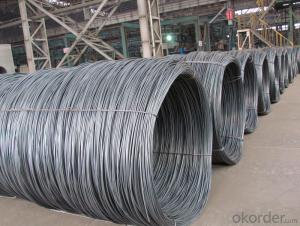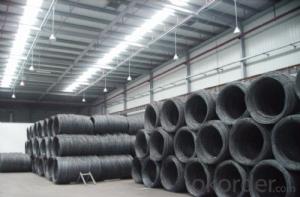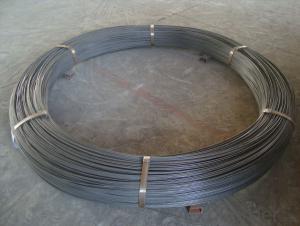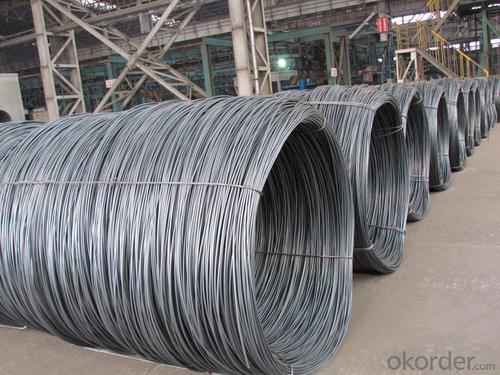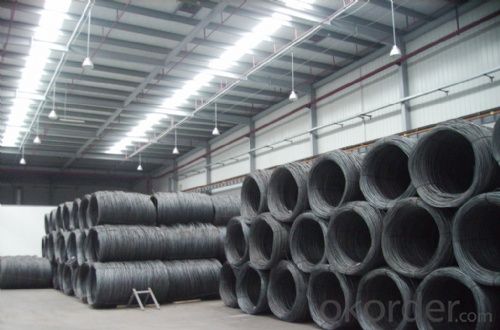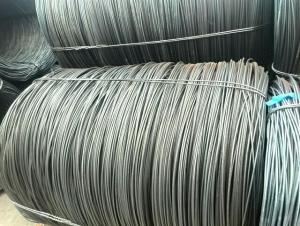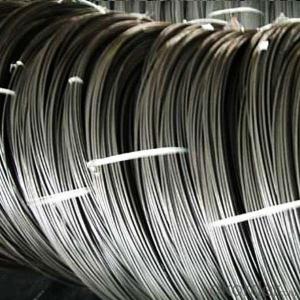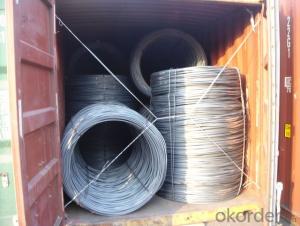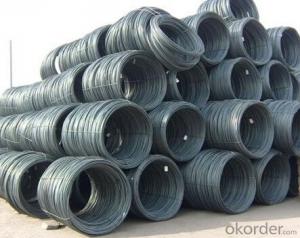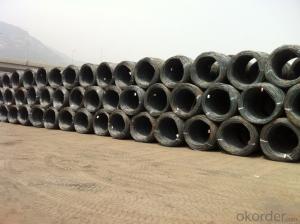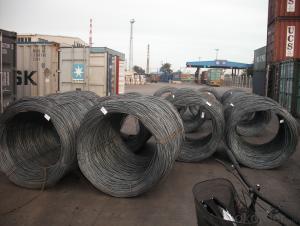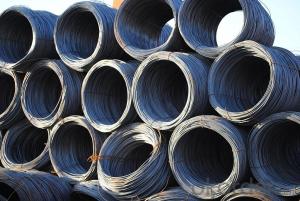High quality hot rolling wire rod(Q195-235)
- Loading Port:
- Tianjin
- Payment Terms:
- TT OR LC
- Min Order Qty:
- 1000 m.t.
- Supply Capability:
- 100000 m.t./month
OKorder Service Pledge
OKorder Financial Service
You Might Also Like
The concept of
Edit
Wire section perimeter is very small, common product specifications diameter is 5-13mm. According to the rolling mill can be divided into different high-speed wire (wire rod) and ordinary wire (S & P line) two.
2 classification
Edit
Wire usually made of ordinary carbon steel and high quality carbon steel.According to the different steel distribution directory and use the wire,including ordinary low carbon steel hot-rolled plate bar, wire rod, high quality carbon steel, Quenched and tempered threaded rods for welding wire, steel wire rope wire, piano wire wire and stainless steel wire rod etc..
Prichard steel
Prichard steel
1 ordinary low carbon steel hot-rolled plate bar (GB701-65), the ordinary low carbon steel hot-rolled plate by low carbon ordinary carbon structural steel oryield point of low carbon structural steel and rolling, is the largest amount ofwire varieties, the most widely used in the wire rod, also known as the cord.
Main application: general line is mainly used in construction of reinforced concrete structure reinforcement steel, cold drawn steel wire can also bedrawn from, as binding etc..
2 ordinary low carbon steel hot rolled wire rod without torsion cold control,(ZBH4403-88), torsion free and controlled cooling, hot rod by torsion free high speed wire rod mill rolling controlled cooling made, material and general line is the same, but without the mechanical properties of hot rolled wire rod torsion cold control, high size precision, good surface quality, high.
Main uses: no twist and controlled cooling, size precision of hot rolled wire rodis divided into A, B, C level three. A, B, C level accuracy is suitable for drawing,construction, packaging and electrode uses, B, C level accuracy is suitable for processing into bolts, screws and nuts.
3 carbon steel wire rod (GB4354-84), the high quality carbon steel wire rod is made of high-quality carbon structural steel and rolling. Is one of the larger amount of wire varieties varieties.
Main purposes: quality carbon steel wire is mainly used for manufacturingcarbon spring steel wire, oil tempered carbon spring steel wire, prestressed steel wire, high strength and high quality carbon structural steel wire,galvanized steel wire, galvanized wire rope etc..
4 high quality carbon steel hot rolled wire rod without torsion cold control,(ZBH44002-88), the high quality carbon steel hot rolled wire rod without torsion cold control, by the torsion free high speed wire rod rolling mill and rolling,controlled cooling process after rolling. Compared with the high quality carbon steel wire rods, high size precision, good surface quality, with high mechanical properties.
Main application: mainly uses the high quality carbon steel wire rod with the same. Commonly used in the manufacturing of carbon spring steel wire, oil tempered carbon spring steel wire, wire, high quality carbon structural steel wire, galvanized steel wire etc..
5 steel wire rod (YB349-64), steel wire for rope with wire is hot rolled quality carbon structural steel strips of disc.
Main purposes: quality carbon structural steel wire rope with wire rod available in 35, 40, 45, 55, 60, 65, 70, 75, 80 and 85 grades of manufacturing. Chemical composition meet the GB699 (technical requirements for steel quality carbon structural) regulations.
Torsion free control of cold and hot rolled wire rods for 6 steel wire(ZBH44004-88), torsion free control of hot and cold rolling plate and used high quality carbon structural steel with steel wire for rope rolling in no twist wire rod mill, the rolling control cooling and made. This rolling into wire rod, high size precision, good surface quality, excellent mechanical performance.
Main uses: mainly used for drawing steel wire and steel wire strand.
7 carbon welding steel wire rod (GB3429-82), carbon welding steel wire rodmade of low carbon hot rolled quality carbon structural steel made.
Main uses: mainly used in the manufacture of manual electric arc weldingelectrode.
8 carbon welding rod steel torsion free and controlled cooling, hot rod(ZBH44005-88), carbon welding rod steel torsion free and controlled cooling,hot rod is blocked in a twisted wire rod rolling, and rolling control cooling and made. The high size precision, good surface quality, superior performance, is a kind of high quality welding steel wire rod.
Main uses: mainly used for carbon steel hot rolled strip steel core discmanufacturing welded with the medicine skin.
9 structural alloy steel hot rolled wire coil (GB3077-82), alloy structure steelhot rolled wire rods by alloy structure steel as material and rolling. Alloystructural steel has a total of 26 Steel Group, 78 steel grades. Each productionplant according to any requirements and different use of selected grades for production.
Main uses: mainly used for structural alloy hot rolled wire drawing steel wire,metal products and structures.
10 carbon tool steel hot rolled wire coil (GB1298-86), carbon tool steel by high quality or high quality high carbon steel and rolling. The processing performance and wear-resisting performance is good, the price is cheap.
Main uses: mainly used for drawing steel ratio and manufacturing tools etc..
11 alloy tool steel hot rolled wire rod (GB1299-77)
Alloy tool steel is in the matrix of the carbon tool steel adding chromium,tungsten, molybdenum, vanadium, silicon, manganese, nickel and cobalt alloyelements and tempered steel. Compared with the carbon tool steel. It has good hardenability and cracking tendency of small, wear resistance and high heat resistance characteristics of heat treatment. Alloy tool steel, alloy tool steel hot rolled wire rod is composed of 5 steel group of 33 steel as the material and rolling. Are produced by the unit of the Dalian steel plant, Benxi steel andShaanxi steel etc..
Main purpose: is used for making the measuring tools, tools and cold and hot working die, shock resistant tool etc..
12 hot rolled spring steel wire rod (GB1222-84)
Spring steel is used in steel manufacturing springs or elastic element. The spring and the elastic element is mainly the use of the elastic deformationenergy absorption and storage, to mitigate the vibration and impact of theparts or do some action for the purpose of. Because it is periodic alternating inshock, vibration or long-term uniform stress conditions, so the requirements of spring steel has a high yield strength, especially to a higher ratio of yield strength (yield strength and tensile strength ratio) and the fatigue strength ofhigh elasticity
- Q: How is steel wire rod used in the manufacturing of wire for shipbuilding applications?
- Steel wire rod is a crucial component in the manufacturing of wire for shipbuilding applications due to its high strength and durability. The process of manufacturing wire for shipbuilding applications begins with the selection of high-quality steel wire rod as the raw material. The steel wire rod is first thoroughly inspected and tested to ensure its compliance with industry standards for strength, corrosion resistance, and other essential properties. Once approved, the wire rod is then sent to the wire drawing process. In the wire drawing process, the steel wire rod is pulled through a series of dies to reduce its diameter and increase its length. This process is repeated multiple times until the desired diameter and length of the wire are achieved. The wire drawing process also enhances the strength and surface quality of the wire, making it suitable for shipbuilding applications where high tensile strength and corrosion resistance are crucial. After the wire drawing process, the wire is usually subjected to additional treatments such as annealing or heat treatment to further improve its mechanical properties. These treatments help to enhance the wire's strength, ductility, and resistance to fatigue, making it suitable for withstanding the harsh conditions experienced in shipbuilding. Once the wire has been processed and treated, it is spooled onto large reels or coils for ease of handling during the shipbuilding process. The wire is then used in various shipbuilding applications such as structural supports, cables, rigging, and other critical components that require high strength and durability. Overall, steel wire rod plays a vital role in the manufacturing of wire for shipbuilding applications by providing the necessary strength, durability, and corrosion resistance required in marine environments. Its versatility and reliability make it an indispensable material in the construction of ships that can withstand the challenges of the sea.
- Q: How is steel wire rod used in the manufacturing of wire forms for wind turbines?
- Steel wire rod is an essential component in the manufacturing process of wire forms for wind turbines. It serves as the raw material that undergoes various processes to transform it into the final wire forms used in wind turbine applications. Firstly, steel wire rod is selected for its high strength and durability, as it needs to withstand the harsh environmental conditions and high loads experienced by wind turbines. The wire rod is typically made of low carbon steel, which offers the desired combination of strength and flexibility. The manufacturing process begins with the wire rod being fed into a wire drawing machine. This machine pulls the wire rod through a series of dies, gradually reducing its diameter and increasing its length. This process is known as wire drawing and helps to improve the wire's mechanical properties, including its tensile strength and surface finish. Once the wire has been drawn to the desired diameter, it is ready for further processing. It may undergo additional treatments such as heat treatment or surface coating to enhance its properties. Heat treatment can provide improved strength and flexibility, while surface coating can protect against corrosion and abrasion. After the necessary treatments, the wire is then formed into the desired shape for wind turbine components. This can be done through various methods such as bending, twisting, or welding. These forming processes are crucial in creating wire forms that can effectively support and transmit the mechanical loads experienced by wind turbines. The wire forms manufactured from steel wire rod are used in various applications within wind turbines. They can be used as support structures for the blades, providing stability and strength. Additionally, wire forms are used as electrical conductors, transmitting power generated by the wind turbine to the electrical grid. In conclusion, steel wire rod plays a vital role in the manufacturing of wire forms for wind turbines. Its high strength, durability, and versatility make it an ideal material for withstanding the demanding conditions and loads experienced by wind turbines. Through various processes, the wire rod is transformed into wire forms that serve as crucial components in wind turbine construction and operation.
- Q: How is steel wire rod used in the production of wire ropes for marine applications?
- Steel wire rod is an essential component in the production of wire ropes for marine applications. Wire ropes are widely used in the marine industry for various purposes such as mooring, towing, lifting, and rigging operations. Steel wire rod, which is typically made from high carbon steel, serves as the raw material for manufacturing wire ropes. The wire rod undergoes a series of processes to transform it into the final product. Firstly, the wire rod is drawn through a series of dies to reduce its diameter and increase its length. This process is known as wire drawing and is performed to achieve the desired size and strength of the wire rope. The drawn wire is then coated with a lubricant to enhance its corrosion resistance and reduce friction during the subsequent processes. Next, the lubricated wire is twisted together with other wires to form strands. These strands are then helically laid around a core wire to create the wire rope. The core wire can be made of steel or a synthetic material depending on the specific application requirements. The strength and durability of the wire rope depend on the quality of the steel wire rod used. The high carbon content in the wire rod provides the necessary strength and load-bearing capacity required for marine applications. Additionally, the wire rod's resistance to corrosion is crucial in ensuring the longevity and reliability of the wire rope in harsh marine environments. Furthermore, the mechanical properties of the wire rod, such as tensile strength and ductility, are crucial factors in determining the performance of the wire rope. These properties enable the wire rope to withstand heavy loads, resist deformation, and endure the dynamic forces encountered during marine operations. In conclusion, steel wire rod plays a critical role in the production of wire ropes for marine applications. Its high strength, corrosion resistance, and mechanical properties make it an ideal raw material for manufacturing wire ropes that can withstand the demanding conditions of the marine industry.
- Q: What are the different factors that affect the mechanical properties of steel wire rod?
- The different factors that affect the mechanical properties of steel wire rod include the composition of the steel, the manufacturing process used, the heat treatment applied, the presence of impurities or defects, the grain size and orientation, the level of cold work or deformation, and the environmental conditions during use.
- Q: What are the different surface finishing materials used for steel wire rod?
- There are several surface finishing materials used for steel wire rod, each offering unique properties and benefits. Some of the commonly used surface finishing materials for steel wire rod include: 1. Zinc Coating: Zinc coating, also known as galvanizing, is one of the most common surface finishing materials used for steel wire rod. It involves applying a layer of zinc to the surface of the wire rod through a hot-dip or electroplating process. Zinc coating provides excellent corrosion resistance and acts as a sacrificial anode, protecting the underlying steel from rust and corrosion. 2. Phosphate Coating: Phosphate coating is another widely used surface finishing material for steel wire rod. It involves treating the wire rod with a phosphate solution, which creates a thin layer of phosphate crystals on the surface. Phosphate coating improves the adhesion of subsequent coatings, such as paint or powder coating, and provides enhanced corrosion resistance. 3. Epoxy Coating: Epoxy coating is a thermosetting polymer that is applied as a protective layer on the surface of steel wire rod. It provides excellent resistance against chemicals, abrasion, and corrosion. Epoxy coating also improves the wire rod's durability and extends its service life. 4. Powder Coating: Powder coating is a popular surface finishing method that involves electrostatically applying a dry powder to the steel wire rod's surface. The powder is then cured under heat, forming a hard and durable coating. Powder coating offers a wide range of colors and finishes, improved resistance to chipping and scratching, and enhanced corrosion protection. 5. Chrome Plating: Chrome plating is a surface finishing process that involves depositing a layer of chromium onto the steel wire rod's surface. Chrome plating provides excellent corrosion resistance, wear resistance, and a decorative finish. It is commonly used in applications where aesthetics, durability, and corrosion protection are crucial. 6. Nickel Plating: Nickel plating is another surface finishing material used for steel wire rod. It involves depositing a layer of nickel onto the wire rod's surface, providing enhanced corrosion resistance and a bright finish. Nickel plating also improves the wire rod's solderability and facilitates better electrical conductivity. These are just a few examples of the different surface finishing materials used for steel wire rod. The choice of coating or plating depends on the specific requirements of the application, such as corrosion resistance, aesthetics, and functional properties.
- Q: What are the main factors affecting the market investments of steel wire rod?
- Some of the main factors affecting the market investments of steel wire rod include supply and demand dynamics, global economic conditions, government policies and regulations, technological advancements, competition from alternative materials, and fluctuations in raw material prices. Additionally, factors such as infrastructure development, construction and manufacturing activities, and the overall health of industries that use steel wire rod also play a significant role in influencing market investments.
- Q: What is the manufacturing process of steel wire rod?
- The manufacturing process of steel wire rod involves several steps. It begins with the melting of iron ore and other materials in a blast furnace. The molten iron is then refined and converted into steel through various processes such as oxygen blowing, electric arc furnaces, or basic oxygen furnaces. Once the steel is produced, it is cast into billets or blooms, which are then hot rolled into wire rod form. The hot rolling process involves passing the billets or blooms through a series of rollers to reduce their thickness and shape them into long, continuous wire rods. After hot rolling, the wire rods are cooled, straightened, and cut into desired lengths. They may undergo additional treatments like surface finishing, heat treatment, or galvanization depending on their intended use. Finally, the wire rods are coiled and packaged for shipment to various industries where they are further processed or used directly in applications such as construction, automotive, or manufacturing.
- Q: What are the different methods of joining steel wire rod?
- There are several methods of joining steel wire rods, including welding, mechanical connectors, and adhesive bonding. Welding involves melting the ends of the wire rods and fusing them together, creating a strong and permanent joint. Mechanical connectors use bolts, screws, or clamps to secure the wire rods together, providing a secure and removable connection. Adhesive bonding involves using specialized adhesives to bond the wire rods together, creating a strong and durable joint without the need for heat or mechanical fasteners. Each method has its own advantages and is chosen based on the specific application and requirements.
- Q: How does the yield strength of steel wire rod vary with different heat treatment processes?
- The yield strength of steel wire rod can vary significantly with different heat treatment processes. Heat treatment processes such as annealing, quenching, and tempering can affect the microstructure and mechanical properties of the steel wire rod. Annealing, for example, involves heating the wire rod to a specific temperature and then slowly cooling it, which can result in a softening of the material and a lower yield strength. On the other hand, quenching involves rapidly cooling the wire rod, which can result in a hardened material with a higher yield strength. Tempering, a process that follows quenching, can further modify the yield strength by reducing brittleness and increasing toughness. In summary, the specific heat treatment process used on steel wire rod can have a significant impact on its yield strength, ultimately determining the mechanical properties of the material.
- Q: What are the main factors affecting the market sales of steel wire rod?
- The main factors affecting the market sales of steel wire rod include the overall demand for steel products, economic conditions, industrial production and construction activity, global trade and competition, raw material availability and costs, technological advancements, and government policies and regulations.
Send your message to us
High quality hot rolling wire rod(Q195-235)
- Loading Port:
- Tianjin
- Payment Terms:
- TT OR LC
- Min Order Qty:
- 1000 m.t.
- Supply Capability:
- 100000 m.t./month
OKorder Service Pledge
OKorder Financial Service
Similar products
Hot products
Hot Searches
Related keywords
